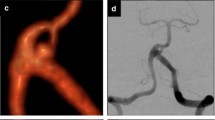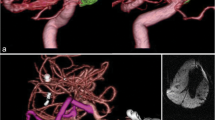Abstract
We report 28 patients with nonsurgical intracranial aneurysms referred by neurosurgeons for endovascular treatment using platinum detachable coils (GDC, Target Therapeutics, Fremont, Calif., USA). Because of unfavourable anatomical features or failed hyperselective catheterisation, 4 patients were not treated. In the other 24 patients (26 aneurysms) embolisation was successful. No manufacturing defect was detected in the coils used. Complete occlusion of the sac was obtained in 22 of the 26 aneurysms (85 %) regardless of their size. The glasgow outcome score was good on discharge in 20 of the 24 patients (83 %). The Karnovski score at 3 months after embolisation revealed that 20 patients (83 %) lead a normal life, with minor neurological signs. Morbidity related directly to treatment occurred in 2 cases (8 %): a superior hemianopia due to mass effect on the optic nerve from a carotid-ophthalmic aneurysm, and hemiparesis due to an embolus. Five transient deficits lasting hours to a few days were related to proven or suspected emboli. No death occurred. Anatomical, technical and clinical data are reported; the mean cost of materials (catheters and coils) per patient and aneurysm was FF 13 500. The mean hospitalisation time was 6.5 days in the neurosurgical department with 2.8 days of intensive care.
Similar content being viewed by others
References
Guglielmi G, Guerrisi R, Guidetti B, et al (1983) Ueletrotrombosi intravasale nelle malformazioni vascolari sperimentalmente provocate. In: Carella A (ed) Proceedings of the Third Congress of the Italian Society of Neuroradiology. Associazione Italiana du Neuroradiologia, Bari pp 139–146
Guglielmi G, Vinuela F, Sepetka I, et al (1991) Electrothrombosis of saccular aneurysms via endovascular approach, part 1. Electrochemical basis, technique and experimental results. J Neurosurg 75: 1–7
Guglielmi G, Vinuela F, Dion J, Duckwiler G (1991) Electrothrombosis of saccular aneurysms via endovascular approach, part 2. Preliminary clinical experience. J Neurosurg 75: 8–14
Atkinson JLD, Sundt TM, Houser OW, Whisnant JP (1989) Angiographic frequency of anterior circulation intracranial aneurysms. J Neurosurg 70: 551–555
Pakarinen S (1967) Incidence, aetiology and prognosis of primary subarachnoid haemorrhage: a study based on 589 cases diagnosed in a defined urban population during a defined period. Acta Neurol Scand 43 [Suppl 29]: 1–128
Phillips LH, Whisnant JP, O'Fallon WM, et al (1980) The unchanging pattern of subarachnoid hemorrhage in a community. Neurology 30: 1034–1040
Kassel NF, Torner JC (1983) Aneurysmal rebleeding: a preliminary report from the cooperative aneurysm study. Neurosurgery 13: 479–489
Jane JA, Kassel NF, Torner JC, Winn HR (1985) The natural history of aneurysms and arteriovenous malformations. J Neurosurg 62: 321–323
Sahs AL, Nibbelink DW, Torner JC (1981) Aneurysmal subarachnoid hemorrhage. Report of the cooperative study. Urban and Schwarzenberg, Baltimore
Weir B (1987) Aneurysms affecting the nervous system. Williams and Wilkins, Baltimore
Peerless SJ, Drake CG (1985) Posterior circulation aneurysms. In: Wilkins RH, Rengachay SS (eds) Neurosurgery, vol 2. McGraw-Hill, New York, pp 1167–1917
Romondanov AP, Shcheglov V (1982) Intravascular occlusion of saccular aneurysms of cerebral arteries by means of a detachable balloon catheter. In: Krayenbuhl A (ed) Advances and technical standards in neurosurgery, vol 9. Springer, New York Berlin Heidelberg, pp 25–49
Debrun G, Fox A, Drake C, et al (1981) Giant unclippable aneurysms: treatment with detachable balloons. AJNR 2: 167–173
Berenstein A, Ransohoff J, Kupfersmith M, et al (1984) Transvascular treatment of giant aneurysms of the cavernous carotid and vertebral arteries: functional investigation and embolization. Surg Neurol 21: 3–21
Higashida RT, Halbach VV, Hieshima GB (1989) Treatment of complex intracranial aneurysms by interventional techniques. In: Margulis AR, Gooding CA (eds) Diagnostic radiology. University of California, San Francisco, pp 357–360
Mercier P, Brassier G, Cronier P, Fournier D, Reignier B, Velut S, Pillet J (1993) Microsurgical anatomy of the perforating arteries of the anterior part of the circle of Willis. Riv Neuroradiol 6 [Suppl 3]: 31–33
Author information
Authors and Affiliations
Rights and permissions
About this article
Cite this article
Martin, D., Rodesch, G., Alvarez, H. et al. Preliminary results of embolisation of nonsurgical intracranial aneurysms with GD coils: The 1st year of their use. Neuroradiology 38 (Suppl 1), S142–S150 (1996). https://doi.org/10.1007/BF02278143
Received:
Accepted:
Issue Date:
DOI: https://doi.org/10.1007/BF02278143




